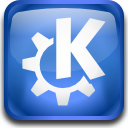
 | Working with Kate |
| Prev | The Fundamentals | Next |
Quick Start will show you how to toggle four simple options that will let you configure some of Kate's more powerful features right away. Shortcuts lays out some of the default keystroke shortcuts for those who can't or don't want to use a mouse.
This section will describe some of the items on the menu so that you can quickly configure Kate to work the way you want it.
When you start Kate for the first time you'll see two windows with white backgrounds. Above the two windows is a toolbar with the usual labeled icons. And above that, a menubar.
The left-hand window is a side bar. It combines the Documents and Filesystem Browser windows. Switch between the two by clicking on the tabs to the left of the window.
If you've started Kate with a file, the right-hand window will show the file you are editing and the Documents on the side bar will show the name of the file. Use the Filesystem Browser window to open files.
You can toggle the Documents and Filesystem Browser window on and off in → menu. This menu offers you your first glimpse into Kate's power and flexibility. In this section we'll look at three items:
Toggles the Documents on and off. If the Documents/Filesystem Browser window is not open, Kate launches the side bar as a separate, undocked, window. To dock the window grab the two thin parallel lines above the tabs by clicking on them with your mouse button and holding the button down. Drag the window into Kate's editing window and release the mouse button when you have positioned the Documents/Filesystem Browser window as you prefer.
If you have grabbed the two parallel lines successfully your mouse pointer will turn into two crossed arrows as you drag.
Toggles the Filesystem Browser on and off. This menu item is the same as with one difference. Toggling it on launches the window with the Filesystem Browser on top.
Toggles a terminal emulator on and off at the bottom of Kate's window. In other words, it gives you a command line within the application.
Many of Kate's keystroke commands (shortcuts) are configurable by way of the Settings menu. By default Kate honors the following key bindings.
Insert | Toggle between Insert and Overwrite mode. When in insert mode the editor will add any typed characters to the text and push any previously typed data to the right of the text cursor. Overwrite mode causes the entry of each character to eliminate the current character. |
Left Arrow | Move the cursor one character to the left |
Right Arrow | Move the cursor one character to the right |
Up Arrow | Move the cursor up one line |
Down Arrow | Move the cursor down one line |
Page Up | Move the cursor up one page |
Page Down | Move the cursor down one page |
Backspace | Delete the character to the left of the cursor |
Home | Move the cursor to the beginning of the line |
End | Move the cursor to the end of the line |
Delete | Delete the character to the right of the cursor (or any selected text) |
Shift+Enter | Insert newline including leading characters of the current line which are not letters or numbers. It is useful e.g. to write comments in the code: At the end of the line “// some text” press this shortcut and the next line starts already with “// ”. So you do not have to enter the comment characters at the beginning of each new line with comments. |
Shift+Left Arrow | Mark text one character to the left |
Shift+Right Arrow | Mark text one character to the right |
F1 | Help |
Shift+F1 | |
Ctrl+F | |
F3 | |
Ctrl+B | Set a Bookmark |
Ctrl+C | Copy the marked text to the clipboard. |
Ctrl+N | New document |
Ctrl+P | |
Ctrl+Q | Quit - close active copy of editor |
Ctrl+R | |
Ctrl+S | Save your file. |
Ctrl+V | Paste. |
Ctrl+X | Delete the marked text and copy it to the clipboard. |
Ctrl+Z | |
Ctrl+Shift+Z |
| Prev | Contents | Next |
| The Fundamentals | Up | Working With the Kate MDI |